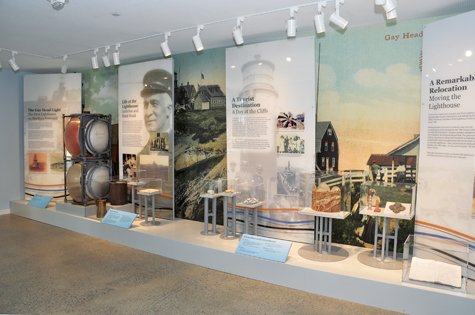COMMUNITY

One Island, Many Stories
The New Martha's Vineyard Museum Shining a Light on Island History
By Amelia Smith Photography by Charlie Utz
One of the first impressions entering the museum is the “One Island, Many Stories” Exhibit (top). It’s an opportunity to learn about the Island through the lenses of farming, fishing, evolving, voyaging, creating, escaping, and belonging. The exhibit encompasses many Island communities and characteristics. An aerial view (above) shows the existing 1895 building and the modern additions. The two story first-order Fresnel Lens (opposite) dominates the next space, its 1008 prisms are on display at eye level on the second floor. This was the light that shone from the Gay Head lighthouse from 1854 to 1952, and it’s one of the museum’s signature pieces.
The Martha’s Vineyard Marine Hospital hid behind a stand of trees, practically invisible to most visitors and Islanders despite its part in the history of the Island. Meanwhile, the Martha’s Vineyard Museum lived on a quiet side street in Edgartown, open to the public but also somewhat out of sight. Coming together, both have emerged into full view, showcasing and celebrating the many stories of life on our Island. The Marine Hospital was built in 1895 and served as a hospital through WWII, after which it became a summer camp then fell into disuse. The museum began its life in 1922 as the Dukes County Historical Society, becoming the Martha’s Vineyard Museum in 2006. The move to Vineyard Haven was a massive logistical undertaking but it has brought the museum far more space to work with, enabling the expansion of its exhibits and programming, as well as increased visibility.
“This is the Island’s museum,” says Executive Director Phil Wallis. “We want to be unifying. We want to be thought-provoking. We want to be surprising. We want you to go, ‘Wow!’” Visitors have flocked to the new museum. On the free Tuesday evenings admission is free, thanks to Cape Cod 5 and Cronig’s Markets, and there are lectures, performances, and other special events. Visiting the museum is a chance to see what’s new and old, to discover stories of the Island’s people and cultures, and learn about the Island itself.
Architect Conrad Ello worked to transform the old building into part of a modern museum. “The fundamental task in museum design is choreographing a visitor experience,” Conrad says. “How does one build toward an ‘aha’ moment inside the museum, something that is impactful for the visitor?” The architect wants the experience to be enriching and rewarding, but also to create opportunities for moments of reflection and drama. That begins with the climb up the hill, culminating in a commanding water view.
The building itself is next, offering a glimpse back into 1895. “The Marine Hospital was a grand building that had participated in the life and fabric of Vineyard Haven for many many years, up on this windswept plain. Post-1950, it got lost a little bit in the history of the town as the trees along the terrace hillside grew in,” Conrad says. “The emphasis of our preliminary study on the site was to restore the building’s presence in the town of Vineyard Haven by trying to restore the late 19th century context of this windswept, treeless plateau overlooking Vineyard Haven Harbor. Removing the trees immediately brought the building back into the memory of the town. As you come in on the ferry it’s there, facing you as you approach.”
“It’s a beautiful building, it has great proportions, and it’s a part of the history of the Island,” says architect Conrad Ello. “There was great high-resolution photography from right after the marine hospital was built in 1895, so we were able to restore it to that original condition.” In a way, the building is the biggest piece in the museum’s collection, but it presents challenges – it certainly wasn’t built with the needs of a 21st century museum in mind.
“The drawbacks of this place are also advantages, in terms of its beauty as a historic building,” says chief curator Bonnie Stacy. “The big windows, the light and air, are very much in keeping with the medical philosophy of the time, but light is not good for museum collections. We compensated for that; we installed room-darkening shades on all of the windows. From the outside, it looks just the way it looked when it was built, but the inner storm windows block UV rays.”
Climate and light control are also a boon for the museum’s ability to put on special exhibits. This summer’s Thomas Hart Benton exhibition was made possible by loans from museums and private collectors, loans that would have been impossible to secure on the museum’s old Edgartown campus. The Benton exhibit explores the role of the Island in the artist’s work and includes the “dueling portraits” of Thomas Hart Benton and Denys Wortman, which were painted in Chilmark in 1953 and are here for the first time since that long-ago summer. August special exhibits will include “Soul Cup: From James Naismith to the Inkwell” and two special exhibits about the Martha’s Vineyard Agricultural Society and the Fair. You never have to wait long to see something new at the museum. The Jewel Box is a room that showcases one object, often a new acquisition, and it changes every couple of weeks.
The “On This Site” exhibit explores the historical significance of the Museum’s site and campus. Soon after breaking ground, construction crews ran into lead paint and asbestos which hadn’t been uncovered in earlier studies. They also found native American features in the ground. “Ironically, that initial challenge turned into a magical, mission-driven action which took the history of the property back 8000 years,” Phil says. Next is “One Island, Many Stories,” an opportunity to learn about the Island through the lenses of farming, fishing, changing, voyaging, creating, escaping, and belonging. The exhibit encompasses many Island communities, characters and characteristics.
Walking past a display about Nancy Luce and her famous chickens, you enter the Linnemann Pavilion. An enormous first-order Fresnel Lens dominates the space, sitting in the stairwell, its 1008 prisms on display right at eye level. This was the light that shone from the Gay Head lighthouse from 1854 to 1952, and it’s one of the museum’s signature pieces. The exhibits around it feature the Island’s light-houses, navigation, and stories of marine rescue and salvage. There’s also a cafe, where you can enjoy a hot bowl of soup or a cup of coffee while enjoying the view of Lagoon and the hill-top through a wall of glass.
Downstairs is the Hands on History area, where children can play in a boat, dig in the sand, visit a fishing shack, and learn about Laura Jernegan, an Island girl who sailed on a whaling ship with her family. “Laura Jernegan is a jumping off point for a lot of things,” says Education Director Beth Seabourne. “Whaling made our world smaller, it brought a lot of cultures together.” There are also trees that change seasonally, a chance to learn about the Island’s natural world. The space is designed with children in mind, and they can become very absorbed in their play there, but there’s plenty of information for adults, as well, which is a good thing because children can become very absorbed in their play here. Beth says that the children often want to stay and play for longer than the adults anticipated.
Back upstairs and outside, across from the main entrance, Doherty Hall is an uninsulated barn-like structure that was built to house the museum’s big things; boats, carriages, and whale jaws, to name a few. It’s also a multi-purpose building, a place for warm-weather lectures and concerts. The central exhibits are on casters so that they can be moved to the sides like a stage set to make room for a performance and seating, with the doors open so that people on the lawn can hear, too.
The final built element of the museum is the Rose Styron poetry and meditation garden, currently under construction. Master stonemason Lew French came out of retirement to build it – it is the first and only public space that he’s created on the Island. “Our programming out there is going to be about poetry, activism, and human rights,” Phil says. “It’s a beautiful, natural, spiritual space.”
Anna Barber, Manager of Exhibitions and Programming, is exploring the potential of the new museum. “Many of the programs we’re doing this year are testing the waters with this space and finding out what people are interested in,” she says. “We want the museum to be a warm and welcoming place for people to come and visit.” And people do visit. There have been over seven thousand visitors so far this summer, thousands more than the busiest season in Edgartown. “Every time I come there’s something new to see and enjoy,” one visitor said to another. They compared notes on the lectures they’d come to, and wondered what they would see next. A family came for a short visit and wound up spending almost three hours exploring and relaxing on the lawn.
The new campus has already become a landmark. “We think of this as a community asset, like a park,” Phil says, and it is a community space. If you live on the Island, you’re sure to see something – or someone – familiar, and if you’re new you can overhear conversations about who knew who when, family and working relationships. The museum’s mission statement is: “The Martha's Vineyard Museum inspires all people to discover, explore, and strengthen their connections to this Island and its diverse heritage,” and it does that every day.
For directions to the museum, hours, and more information, visit mvmuseum.org
The Martha’s Vineyard Marine Hospital hid behind a stand of trees, practically invisible to most visitors and Islanders despite its part in the history of the Island. Meanwhile, the Martha’s Vineyard Museum lived on a quiet side street in Edgartown, open to the public but also somewhat out of sight. Coming together, both have emerged into full view, showcasing and celebrating the many stories of life on our Island. The Marine Hospital was built in 1895 and served as a hospital through WWII, after which it became a summer camp then fell into disuse. The museum began its life in 1922 as the Dukes County Historical Society, becoming the Martha’s Vineyard Museum in 2006. The move to Vineyard Haven was a massive logistical undertaking but it has brought the museum far more space to work with, enabling the expansion of its exhibits and programming, as well as increased visibility.
“This is the Island’s museum,” says Executive Director Phil Wallis. “We want to be unifying. We want to be thought-provoking. We want to be surprising. We want you to go, ‘Wow!’” Visitors have flocked to the new museum. On the free Tuesday evenings admission is free, thanks to Cape Cod 5 and Cronig’s Markets, and there are lectures, performances, and other special events. Visiting the museum is a chance to see what’s new and old, to discover stories of the Island’s people and cultures, and learn about the Island itself.
Architect Conrad Ello worked to transform the old building into part of a modern museum. “The fundamental task in museum design is choreographing a visitor experience,” Conrad says. “How does one build toward an ‘aha’ moment inside the museum, something that is impactful for the visitor?” The architect wants the experience to be enriching and rewarding, but also to create opportunities for moments of reflection and drama. That begins with the climb up the hill, culminating in a commanding water view.
The building itself is next, offering a glimpse back into 1895. “The Marine Hospital was a grand building that had participated in the life and fabric of Vineyard Haven for many many years, up on this windswept plain. Post-1950, it got lost a little bit in the history of the town as the trees along the terrace hillside grew in,” Conrad says. “The emphasis of our preliminary study on the site was to restore the building’s presence in the town of Vineyard Haven by trying to restore the late 19th century context of this windswept, treeless plateau overlooking Vineyard Haven Harbor. Removing the trees immediately brought the building back into the memory of the town. As you come in on the ferry it’s there, facing you as you approach.”
“It’s a beautiful building, it has great proportions, and it’s a part of the history of the Island,” says architect Conrad Ello. “There was great high-resolution photography from right after the marine hospital was built in 1895, so we were able to restore it to that original condition.” In a way, the building is the biggest piece in the museum’s collection, but it presents challenges – it certainly wasn’t built with the needs of a 21st century museum in mind.
“The drawbacks of this place are also advantages, in terms of its beauty as a historic building,” says chief curator Bonnie Stacy. “The big windows, the light and air, are very much in keeping with the medical philosophy of the time, but light is not good for museum collections. We compensated for that; we installed room-darkening shades on all of the windows. From the outside, it looks just the way it looked when it was built, but the inner storm windows block UV rays.”
Climate and light control are also a boon for the museum’s ability to put on special exhibits. This summer’s Thomas Hart Benton exhibition was made possible by loans from museums and private collectors, loans that would have been impossible to secure on the museum’s old Edgartown campus. The Benton exhibit explores the role of the Island in the artist’s work and includes the “dueling portraits” of Thomas Hart Benton and Denys Wortman, which were painted in Chilmark in 1953 and are here for the first time since that long-ago summer. August special exhibits will include “Soul Cup: From James Naismith to the Inkwell” and two special exhibits about the Martha’s Vineyard Agricultural Society and the Fair. You never have to wait long to see something new at the museum. The Jewel Box is a room that showcases one object, often a new acquisition, and it changes every couple of weeks.
The “On This Site” exhibit explores the historical significance of the Museum’s site and campus. Soon after breaking ground, construction crews ran into lead paint and asbestos which hadn’t been uncovered in earlier studies. They also found native American features in the ground. “Ironically, that initial challenge turned into a magical, mission-driven action which took the history of the property back 8000 years,” Phil says. Next is “One Island, Many Stories,” an opportunity to learn about the Island through the lenses of farming, fishing, changing, voyaging, creating, escaping, and belonging. The exhibit encompasses many Island communities, characters and characteristics.
Walking past a display about Nancy Luce and her famous chickens, you enter the Linnemann Pavilion. An enormous first-order Fresnel Lens dominates the space, sitting in the stairwell, its 1008 prisms on display right at eye level. This was the light that shone from the Gay Head lighthouse from 1854 to 1952, and it’s one of the museum’s signature pieces. The exhibits around it feature the Island’s light-houses, navigation, and stories of marine rescue and salvage. There’s also a cafe, where you can enjoy a hot bowl of soup or a cup of coffee while enjoying the view of Lagoon and the hill-top through a wall of glass.
Downstairs is the Hands on History area, where children can play in a boat, dig in the sand, visit a fishing shack, and learn about Laura Jernegan, an Island girl who sailed on a whaling ship with her family. “Laura Jernegan is a jumping off point for a lot of things,” says Education Director Beth Seabourne. “Whaling made our world smaller, it brought a lot of cultures together.” There are also trees that change seasonally, a chance to learn about the Island’s natural world. The space is designed with children in mind, and they can become very absorbed in their play there, but there’s plenty of information for adults, as well, which is a good thing because children can become very absorbed in their play here. Beth says that the children often want to stay and play for longer than the adults anticipated.
Back upstairs and outside, across from the main entrance, Doherty Hall is an uninsulated barn-like structure that was built to house the museum’s big things; boats, carriages, and whale jaws, to name a few. It’s also a multi-purpose building, a place for warm-weather lectures and concerts. The central exhibits are on casters so that they can be moved to the sides like a stage set to make room for a performance and seating, with the doors open so that people on the lawn can hear, too.
The final built element of the museum is the Rose Styron poetry and meditation garden, currently under construction. Master stonemason Lew French came out of retirement to build it – it is the first and only public space that he’s created on the Island. “Our programming out there is going to be about poetry, activism, and human rights,” Phil says. “It’s a beautiful, natural, spiritual space.”
Anna Barber, Manager of Exhibitions and Programming, is exploring the potential of the new museum. “Many of the programs we’re doing this year are testing the waters with this space and finding out what people are interested in,” she says. “We want the museum to be a warm and welcoming place for people to come and visit.” And people do visit. There have been over seven thousand visitors so far this summer, thousands more than the busiest season in Edgartown. “Every time I come there’s something new to see and enjoy,” one visitor said to another. They compared notes on the lectures they’d come to, and wondered what they would see next. A family came for a short visit and wound up spending almost three hours exploring and relaxing on the lawn.
The new campus has already become a landmark. “We think of this as a community asset, like a park,” Phil says, and it is a community space. If you live on the Island, you’re sure to see something – or someone – familiar, and if you’re new you can overhear conversations about who knew who when, family and working relationships. The museum’s mission statement is: “The Martha's Vineyard Museum inspires all people to discover, explore, and strengthen their connections to this Island and its diverse heritage,” and it does that every day.
For directions to the museum, hours, and more information, visit mvmuseum.org








